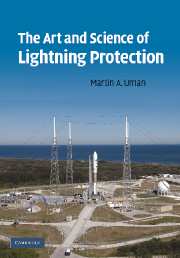Book contents
- Frontmatter
- Contents
- Preface
- 1 What is lightning?
- 2 Lightning damage
- 3 General methods for lightning protection: Faraday cages, topological shields; and more practical approaches: cone of protection and rolling sphere methods
- 4 Structure protection: air terminals and down conductors
- 5 Structure protection: grounding
- 6 Surge protection for electronics in low-voltage electrical systems
- 7 Humans and animals
- 8 Lightning warning
- 9 Airships, airplanes, and launch vehicles
- 10 Ships and boats
- 11 Trees
- 12 Overhead and underground power and communication lines
- 13 Lightning elimination
- 14 So, what do we know and what don't we know about lightning protection?
- Index
- References
13 - Lightning elimination
Published online by Cambridge University Press: 17 November 2009
- Frontmatter
- Contents
- Preface
- 1 What is lightning?
- 2 Lightning damage
- 3 General methods for lightning protection: Faraday cages, topological shields; and more practical approaches: cone of protection and rolling sphere methods
- 4 Structure protection: air terminals and down conductors
- 5 Structure protection: grounding
- 6 Surge protection for electronics in low-voltage electrical systems
- 7 Humans and animals
- 8 Lightning warning
- 9 Airships, airplanes, and launch vehicles
- 10 Ships and boats
- 11 Trees
- 12 Overhead and underground power and communication lines
- 13 Lightning elimination
- 14 So, what do we know and what don't we know about lightning protection?
- Index
- References
Summary
Modifying the cloud electrification process
In many circumstances it would be valuable to suppress or eliminate lightning. One potential way to do so would be to eliminate or reduce the source of lightning, the cloud charge. The primary charging mechanism in a thundercloud is thought to involve interactions between soft hail (graupel) falling under the influence of gravity and lighter ice crystals rising in the cloud's updrafts, all in the presence of liquid water drops not yet frozen but at an altitude where the temperature is colder than the freezing temperature (32 ° or 0 °). Additional information is found in Section 1.1. Since cloud electrification is related to the falling precipitation within the cloud, and since this electrification is what produces lightning, it is reasonable to suppose that the amount of lightning is related to the amount of precipitation that is falling inside and below the cloud. Observationally, this is the case. In fact, one can often estimate the amount of rainfall (melted ice forms) that will reach the ground below a thunderstorm by counting the number of lightning flashes in the storm; the more lightning, the more rainfall (e.g., MacGorman and Rust 1998, Table 7.6; Takayabu 2006; Gungle and Krider 2006). For example, for nine isolated thunderstorms in Florida, Gungle and Krider (2006) found that each cloud-to-ground lightning flash was accompanied by an average rain volume of 2.6 × 104 ± 2.1 × 104 m3 (or a mean rainwater mass of 2.6 × 107 kg) as measured by rain gauges on the ground.
Information
- Type
- Chapter
- Information
- The Art and Science of Lightning Protection , pp. 220 - 231Publisher: Cambridge University PressPrint publication year: 2008
